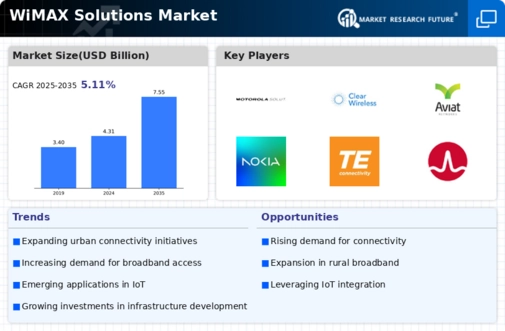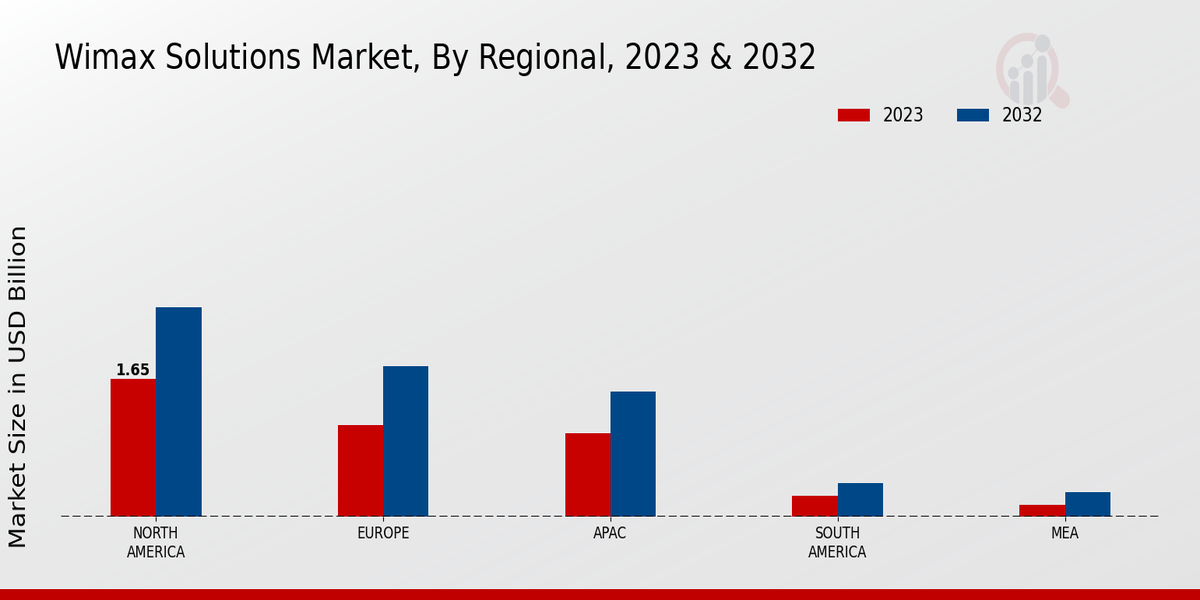Market Growth Projections
The Global WiMAX Solutions Market Industry is projected to experience substantial growth in the coming years. With a forecasted market size of 4.31 USD Billion in 2024 and an anticipated increase to 7.55 USD Billion by 2035, the industry is set to expand significantly. The compound annual growth rate of 5.22% from 2025 to 2035 indicates a robust demand for WiMAX solutions, driven by various factors such as urbanization, technological advancements, and the increasing need for high-speed internet. This growth trajectory suggests that WiMAX will continue to play a vital role in the global telecommunications landscape.
Cost-Effectiveness of Deployment
The Global WiMAX Solutions Market Industry is characterized by the cost-effectiveness of deploying wireless broadband solutions. Compared to traditional fiber-optic networks, WiMAX technology can be implemented with lower infrastructure costs, making it an attractive option for service providers. This affordability is particularly relevant in developing regions, where budget constraints often limit the expansion of internet services. As a result, the market is likely to witness a compound annual growth rate of 5.22% from 2025 to 2035, driven by the increasing number of operators seeking economical solutions to meet the growing demand for connectivity.
Enhanced Mobile Broadband Services
The Global WiMAX Solutions Market Industry is benefiting from the demand for enhanced mobile broadband services. As mobile devices proliferate and data consumption continues to rise, the need for reliable and high-speed mobile internet becomes critical. WiMAX technology offers a robust solution for mobile broadband, providing users with seamless connectivity. This trend is likely to contribute to the market's growth, with estimates suggesting that the industry could reach 4.31 USD Billion by 2024. The increasing adoption of mobile applications and services further underscores the necessity for advanced broadband solutions, positioning WiMAX as a key player in the mobile internet landscape.
Government Initiatives and Funding
The Global WiMAX Solutions Market Industry is significantly influenced by government initiatives aimed at enhancing broadband access. Many governments are recognizing the importance of digital connectivity for economic growth and social inclusion. Consequently, they are allocating funds and resources to support the deployment of WiMAX technology, particularly in rural and underserved areas. These initiatives not only facilitate the expansion of WiMAX networks but also stimulate private sector investment. As a result, the market is expected to thrive, with projections indicating a growth trajectory that aligns with the increasing focus on digital infrastructure development.
Growing Demand for High-Speed Internet
The Global WiMAX Solutions Market Industry is experiencing a surge in demand for high-speed internet connectivity. As urbanization accelerates and the number of internet users increases, the need for robust broadband solutions becomes paramount. WiMAX technology offers a viable alternative to traditional wired connections, particularly in rural and underserved areas. With the market projected to reach 4.31 USD Billion in 2024, the adoption of WiMAX solutions is likely to expand significantly. This growth is driven by the increasing reliance on digital services, including streaming, online education, and telecommuting, which necessitate reliable and fast internet access.
Support for IoT and Smart City Initiatives
The Global WiMAX Solutions Market Industry is poised to benefit from the rising integration of Internet of Things (IoT) technologies and smart city initiatives. WiMAX provides the necessary infrastructure to support a multitude of connected devices, enabling efficient data transmission and communication. As cities worldwide invest in smart technologies to enhance urban living, the demand for WiMAX solutions is expected to grow. This trend aligns with the projected market growth to 7.55 USD Billion by 2035, suggesting that WiMAX could play a crucial role in the development of smart grids, traffic management systems, and public safety networks.



















